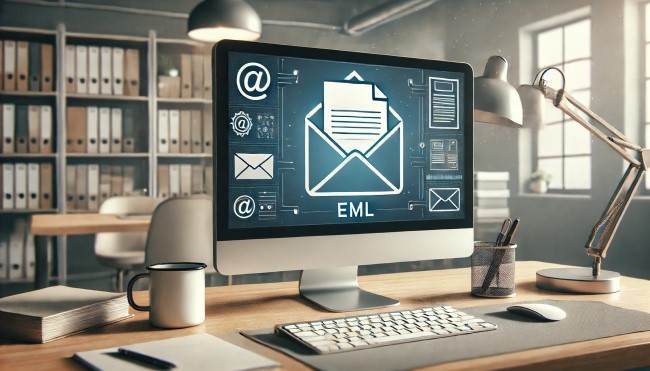EML File: Understanding and Using the Essential Email Format

In today’s digital age, emails are one of the most reliable and widely used methods of communication, especially in professional and business environments. The EML file format has become popular across email platforms for maintaining, organizing, and transferring individual email messages. This article will explore everything you need to know about EML files—from what they are to how they’re used and opened.
What is an EML File?
An EML file is a format for storing individual email messages, including their content, metadata (such as sender and recipient information), and attachments. Originally created by Microsoft for Outlook and Outlook Express, EML files have become widely compatible with other email clients and services.
As a versatile and structured file format, the EML file serves as a comprehensive snapshot of an email, preserving details like:
- Subject line
- Timestamp
- Sender and recipient email addresses
- Text and HTML content of the message
- Attachments embedded within the email
The format itself uses MIME (Multipurpose Internet Mail Extensions), a standard way of formatting Internet messages. This allows it to encapsulate all elements of an email for easy sharing, archiving, and backup.
Why Use EML Files?
The EML file format is favoured for several reasons:
- Portability and Compatibility: Since EML files contain all elements of an email, they can easily be moved between systems and opened on various platforms.
- Archiving: EML files are ideal for preserving individual emails, making them valuable for backup and archiving purposes.
- Legal and Compliance Needs: In legal contexts, EML files serve as evidence since they maintain emails’ original formatting and metadata.
- Easy Transfer and Sharing: The entire email can be transferred as a single file, allowing seamless sharing without losing any part of the message.
How to Open an EML File?
Opening an EML file is straightforward, but it depends on the type of device or software you’re using. Here are some methods:
Using Desktop Email Clients
Many email clients, including Microsoft Outlook, Mozilla Thunderbird, and Apple Mail, support EML files natively. Simply double-clicking the file should open it in the default email program.
Using Webmail Services
For Gmail and other webmail platforms, EML files can be uploaded and previewed by dragging the file into an open email composition window or using specific plugins that support EML file viewing.
Using Text Editors
If no email client is available, you can open an EML file in a text editor like Notepad (Windows) or TextEdit (Mac). However, this will only display the raw, unformatted data, which may include HTML and MIME encoding, making it harder to read.
Online Converters and Viewers
There are also online EML viewers and converters available that allow you to open EML files without installing specific software. However, be cautious when handling sensitive files on third-party platforms.
How to Create an EML File?
Creating an EML file is generally straightforward and can be done in most email clients:
- Outlook: Open the email you want to save, click “File,” select “Save As,” and choose the EML format.
- Thunderbird: Right-click on the email, select “Save As,” and save it as an EML file.
- Apple Mail: Similarly, select the email, choose “File,” then “Save As,” and select EML as the file type.
Many email services and software applications support exporting emails as EML files to ensure platform portability and compatibility.
Differences Between EML and Other Email Formats
There are several email formats, but EML stands out for its simplicity and compatibility. Here’s how it compares to other standard formats:
- EML vs. MSG: MSG files are specific to Microsoft Outlook and are not as widely supported across other email clients. EML files, on the other hand, are versatile and compatible with various platforms.
- EML vs. MBOX: MBOX is used primarily for storing collections of emails rather than individual messages. If you want to save an entire email folder, MBOX might be the better choice, but for single emails, EML is ideal.
- EML vs PDF: PDFs are static, non-editable documents, whereas EML files maintain the email’s original metadata and attachments, making them a better option for email preservation.
When to Use EML Files?
EML files can be helpful in various scenarios:
- Data Migration: EML files can help transfer emails without losing data when switching email clients.
- Legal Evidence: They retain metadata, which can be critical in legal situations where message authenticity is essential.
- Archiving: EML files allow businesses to archive specific emails while preserving all their original attributes.
- Backup and Restoration: Individual emails can be backed up using EML files, ensuring that important messages are never lost.
Advantages of Using EML Files
- Cross-Platform Compatibility: EML files can be accessed across different email clients, making them highly flexible.
- Data Integrity: EML files retain all original metadata, which is crucial for maintaining the integrity of each email.
- Ease of Sharing: Entire emails, including attachments, can be sent as single EML files, simplifying email transfers.
- Archival: EML files are excellent for archiving purposes, as they maintain the email’s original format and attachments.
Disadvantages of EML Files
While EML files offer many benefits, they do have some drawbacks:
- Limited to Individual Messages: Unlike MBOX files that store collections of emails, EML files store only one email per file.
- Security Concerns: EML files can contain malicious links or attachments. Always be cautious when opening EML files from unknown sources.
- Size Limitations: When storing large amounts of emails, managing individual EML files can become tedious and require more storage space.
Conclusion: Why EML Files Are Important
The EML file format is essential for anyone who values email preservation, transferability, and compliance. Whether you’re a business professional managing sensitive communications or an individual backing up important messages, EML files provide a reliable way to store and manage individual emails. With their ease of use across platforms and straightforward storage options, EML files will continue to be valuable tools for email organization and archiving.
Understanding how to create, open, and use EML files can empower users to manage their email data effectively. As digital communication continues to evolve, formats like EML will remain foundational in keeping records intact and secure.

